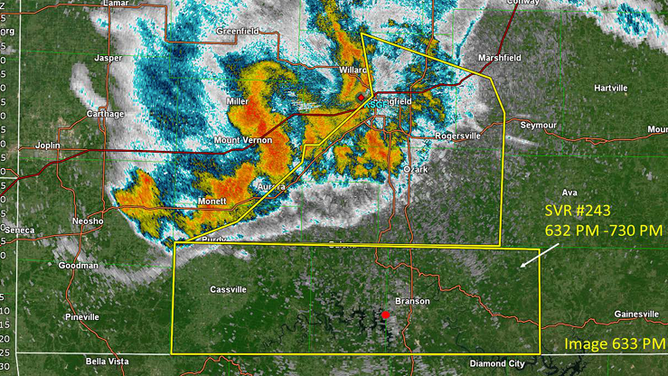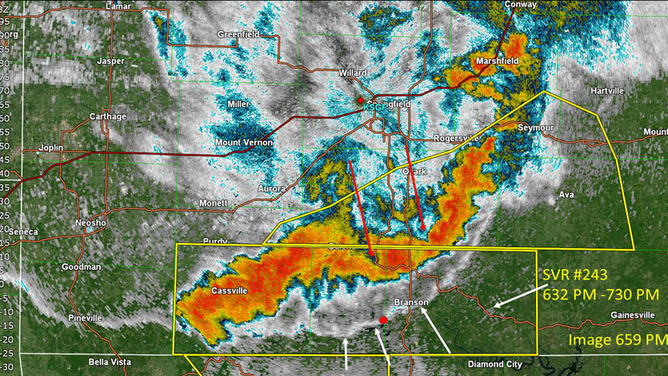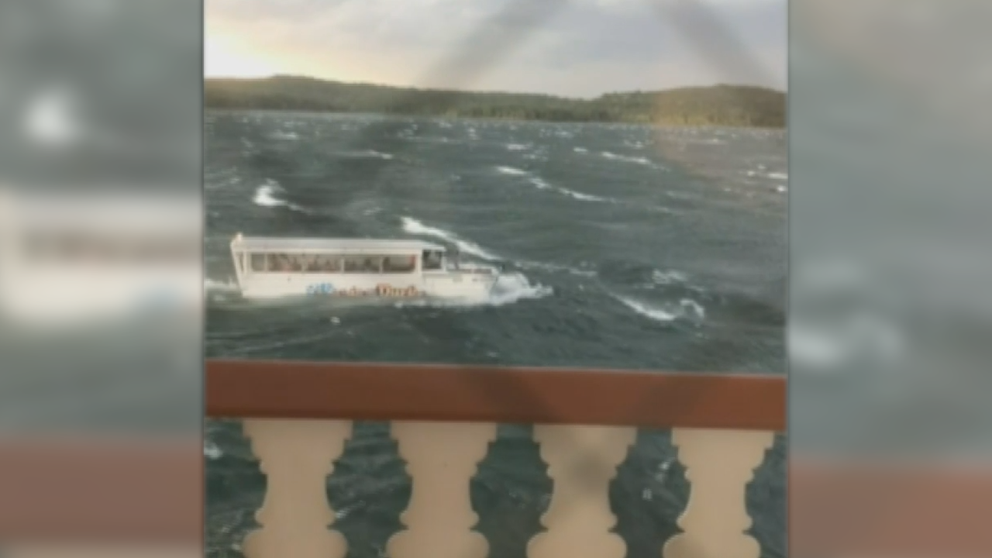Negligence charges tossed in 2018 duck boat catastrophe despite weather warnings before cruise
17 people died when the Ride the Duck boat was overcome with waves amid 70+ mph winds during a tour of Table Rock Lake in July, 2019.
Branson Duck Boat Tragedy
On July 19, 2018, severe weather caused a duck boat on Table Rock Lake in Missouri to capsize and sink, killing 17 out of 31 passengers and crew.
GALENA, Mo. -- Criminal charges against the captain and two administrators in the sinking of the Ride the Ducks amphibious boat that claimed 17 lives near Branson, Missouri, during a severe thunderstorm in 2018 were dismissed Tuesday afternoon after a judge ruled the defendants had no knowledge of an approaching gust front.
The "Stretch Duck 7" amphibious boat entered Table Rock Lake near Branson on the evening of July 19. Less than 10 minutes after entering the water, wind gusts over 70 mph reached the lake, creating waves as high as 4 feet, according to the National Weather Service. The waves overwhelmed the boat and it sank.
The case had centered around alleged neglect by the captain and the tour company's senior administrators in failing to heed weather warnings. Capt. Kenneth Scott McKee and Ride the Ducks administrators Curtis Lanham and Charles Baltzel were each charged with 17 counts of involuntary manslaughter while McKee had 12 additional charges of endangering the welfare of children.
Severe storms create strong gust front
According to a report issued by the National Weather Service in the aftermath of the tragedy, a Severe Thunderstorm Watch had been in effect for the Branson and Table Lake areas since 11:20 a.m. and remained in effect past the time of the sinking. A watch signifies conditions were in place for severe thunderstorms.
WATCH vs. WARNING: HERE ARE THE DIFFERENCES BETWEEN THESE WEATHER TERMS THAT COULD SAVE YOUR LIFE
Just after 5 p.m., Severe Thunderstorm Warnings were issued in parts of west and central Missouri upstream of Branson. A Severe Thunderstorm Warning indicates that thunderstorms with damaging winds and/or large hail are occurring or imminent within the warned area. The path indicated in the warnings showed the line of storms was moving south toward Branson.
The damaging winds were the result of a "gust front", part of a larger system of what the National Weather Service would later term a "derecho"
"A gust front is the rush of colder air from the downdraft from a storm," said FOX Weather Meteorologist Marissa Lautenbacher. "The cold air quickly moves from the storm, runs into the ground and has nowhere to go but away from the storm."
In this case, the judge noted the gust front was pushing about 6-7 miles ahead of the storms.
At 5:45 p.m., a new Severe Thunderstorm Warning was issued that included Branson's Airport and was in effect until 6:30 p.m. and the report noted "significant, widespread tree and other damage occurred within this warning (area)."
As the line of storms continued to move south, a new Severe Thunderstorm Warning was issued at 6:07 p.m. that covered the area just north of Table Rock Lake. Eight minutes later, the National Weather Service updated the warning to increase forecast wind speeds to 70 mph.

Reflectivity image from Springfield, MO National Weather Service Radar at 6:33 p.m. on July 19, 2018. Yellow boxes show Severe Thunderstorm Warnings; red dot is Table Rock State Park.
(National Weather Service)
Another eight minutes later, Branson Airport measured a 74-mph gust.
"There were numerous reports of high winds and damage in the Springfield area, and extensive media coverage of the event occurred - including live television and social media," according to the NWS report.
Judge: Administrators never saw approaching gust front
The judge noted that Ride the Ducks had a weather radar display in their office, and the NWS report stated the tour supervisor and captain reviewed radar data a few minutes later, and the captain was told to take the water portion of the tour first.
While Doppler radars used by the National Weather Service do contain data products that can show detected wind speeds, "the high winds were not visible to the naked eye or on radar imagery relied upon by the defendants," Judge Alan Blankenship wrote in court documents. "Relying on this display, coupled with viewing the skies, likely gave the impression there was sufficient time of the vessels … to complete the water portion of the tour before the storm reached the lake."
‘DESTRUCTIVE’ THUNDERSTORM ALERTS: WHAT THEY ARE AND WHY THE NWS ISSUES THEM
At 6:32 p.m., the National Weather Service issued a Severe Thunderstorm Warning for Branson and Table Rock Lake -- 28 minutes before the event reached the lake and 36 minutes prior to the accident, according to the report. The boat left its home base one minute later and arrived at Table Rock Lake and entered the water at 6:55 as winds were still calm, the report stated.

0.5 degree reflectivity image from Springfield, MO National Weather Service Radar at 6:59 p.m. on July 19, 2018. White arrows show leading edge of outflow.
(National Weather Service)
The gust front arrived five minutes later at 7 p.m. One minute later, the captain made a comment about deteriorating conditions. The captain made two more calls at 7:03 p.m. and 7:05 p.m., the report stated. At 7:07 p.m., a nearby ship recorded a gust of 73 mph.
At 7:08 p.m. all contact was lost with the Ride the Ducks vessel. Video evidence showed the boat struggled in the wind and was eventually overwhelmed by wind-driven waves coming over the bow. Investigators estimated wind speeds at the time of the sinking were near 70 mph with significant wave heights as tall as 4 feet. Sixteen passengers and one crew member died.
In their report after the incident, the National Weather Service noted an "abnormal aspect" of the event was that the arrival of the severe winds "often preceded the rain and even thunder by as much as fifteen minutes." They noted that at Table Rock Lake, the closest cloud-to-ground lightning strike in the 30-minutes before the onset of severe winds was 13.1 miles away and the closest in-cloud flash was 10.9 miles away.
"This meant that vulnerable populations often did not receive any visible or audible cue from thunder prior to the severe winds arriving at their location," the NWS wrote.
In summing up the dismissal of charges, Blankenship wrote, "The evidence is clear the defendants were aware of an approaching storm," but there was no evidence they were aware of the " ‘high winds several miles ahead of the approaching storm’ or the issuance of the severe storm warning effecting (sic) Table Rock Lake issued contemporaneous with SB7 departing the tour."
While the National Weather Service commended its staff for timely and accurate warnings throughout the severe weather event, the agency suggested 13 recommendations in their own investigation after the incident, including forecast offices "should be cognizant of the need for advance information on timing and severity of weather events for vulnerable outdoor populations. This information should take the form of social media posts for the general public, and more specific decision support for government-sector core partners (e.g. state parks, etc.)."
